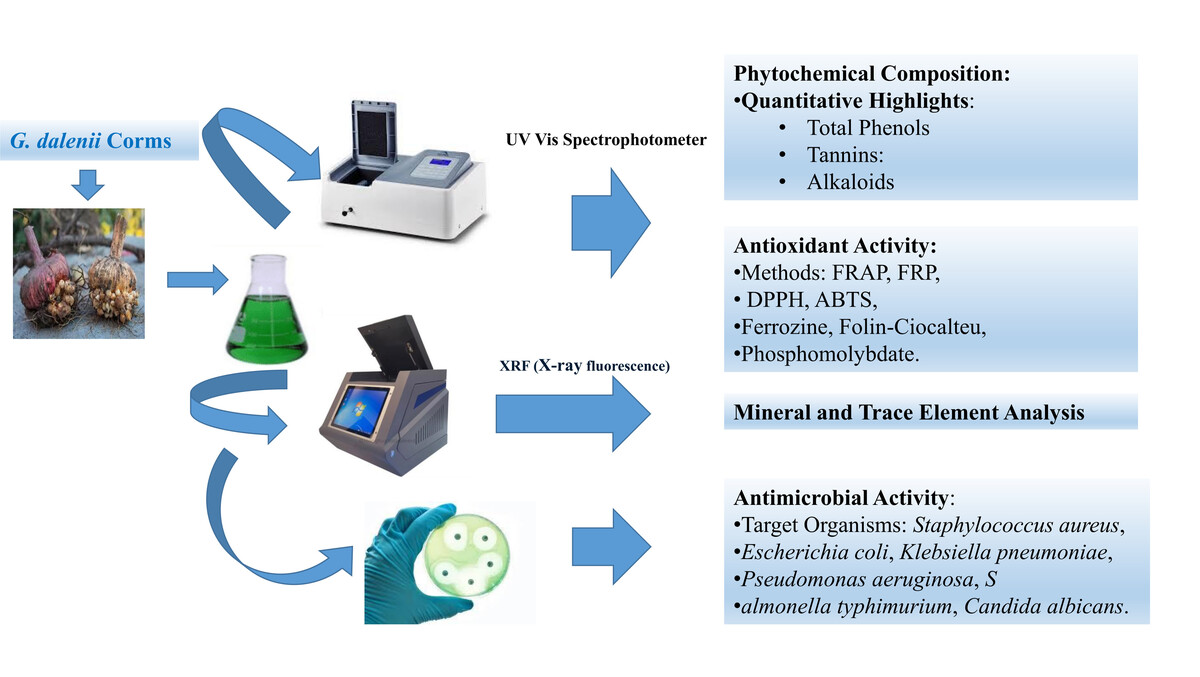Introduction
The growing concern for food safety, human health, and sustainability has driven the search for natural solutions to replace synthetic compounds in food and medicine (Yin, et al., 2023). This study significantly expands the knowledge of Gladiolus dalenii corms through detailed and multifaceted analyses, highlighting their bioactive potential and industrial applications.
For the first time, a quantitative characterization of the minerals in G. dalenii corms was conducted, revealing the presence of essential minerals such as zinc, nickel, copper, and selenium. These elements play critical roles in promoting human health, including immune support and antioxidant activity (Lars-Oliver, Klaus-Dietrich, Darius, & Helmut, 2003). Additionally, the quantification of bioactive compounds such as alkaloids and total tannins revealed novel findings that reinforce the nutraceutical properties of this species.
In the antimicrobial field, previously described inhibitory activity against various clinical pathogens (Ameh, Obodozie, Olorunfemi, Okoliko, & Ochekpe, 2018; Odhiambo, Siboe, Lukhoba, & Dossaji, 2010) was confirmed. Extracts of G. dalenii demonstrated efficacy against Staphylococcus aureus, Salmonella typhimurium, Klebsiella pneumoniae, Pseudomonas aeruginosa, Escherichia coli, and Candida albicans. These results highlight the practical potential of this species for applications as a natural preservative in food and pharmaceutical formulations, offering a viable alternative to synthetic compounds such as Butylated Hydroxytoluene (BHT), Butylated Hydroxyanisole (BHA), and parabens. These synthetic compounds have been widely criticized for mimicking estrogens, potentially causing hormonal imbalances and affecting fertility, development, and other aspects of reproductive health (Pulcastro & Ziv-Gal, 2024; Engeli, et al., 2017).
In the antioxidant field, preliminary studies using the DPPH method had previously associated the antioxidant activity of G. dalenii corms with phenolic and flavonoid compounds, known for neutralizing free radicals and preventing oxidative damage (Cumbane, Magaia, & Estivila, 2022). In the current study, antioxidant evaluation was elaborated with additional methods, such as ABTS (2,2'-azino-bis (3-ethylbenzothiazoline-6-sulfonic acid)), Ferric Reducing Antioxidant Power (FRAP), Phosphomolybdenum (TAC), Folin-Ciocalteu’s method, Ferric Reducing Power (FRP), and Ferrozine, providing a more detailed and comprehensive analysis of the species’ antioxidant capacity. These findings underscore the multifunctional potential of G. dalenii corms and their relevance to both the pharmaceutical and food industries, promoting a sustainable and effective approach to meet the increasing demand for natural, high-value-added products.
Moreover, Gladiolus dalenii corms have proven applications in traditional medicine, being widely used to treat fungal infections, gastrointestinal problems, and wounds. Studies have demonstrated their efficacy, which, under certain conditions, surpasses synthetic compounds (Odhiambo, Siboe, Lukhoba, & Dossaji, 2010; Ameh, Obodozie, Olorunfemi, Okoliko, & Ochekpe, 2018). Recent investigations have also highlighted the cytotoxic and anti-mutagenic activities of extracts from Gladiolus species (Mykhailenko, et al., 2020; Basgedik, Ugur, & Sarac, 2014), as well as the anticonvulsant and sedative properties specific to G. dalenii (Ngoupaye, et al., 2013). These findings suggest promising applications of this species in anticancer and anticonvulsant therapies, broadening its therapeutic and nutraceutical potential. Thus, this study makes a significant contribution to the existing knowledge of G. dalenii, augmenting its potential applications in the food and pharmaceutical industries and in the promotion of human health.
Materials and Methods
Plant Material and Extraction
Fresh samples of Gladiolus dalenii van Geel Hook bulbs were collected in July 2022 in the Bilene district, Gaza province. The authentication of the samples was conducted at the Herbarium of the Botany Department, Institute of Agricultural Research of Mozambique (voucher Nr. 48529), ensuring precise scientific identification and validation for subsequent studies. After peeling and cleaning, the bulbs were washed with distilled water and dried in a hot air oven at 45°C until a constant weight was achieved. The dried material was ground using a stainless-steel grinder (Ultra 750W 3-Jar Mixer Grinder, 110V, USA).
The primary extract (Extract A) was prepared by mixing one part of the dried Gladiolus dalenii powder with 50 parts of 80% ethanol (1:50 ratio). The mixture was subjected to mechanical agitation using an Orbital Shaker (IKA KS 501 Digital) at 200 rpm for 120 minutes. Following agitation, the mixture was centrifuged at 5000 rpm for 15 minutes using an Eppendorf Centrifuge 5810R. The resulting supernatant was carefully decanted and filtered through Whatman No. 1 filter paper. The obtained extract was concentrated to dryness using a rotary evaporator (Rotavapor® R-220, BUCHI) maintained at a constant temperature of 45°C. The procedure was performed in four replicates, with the final average mass determined to be 0.16 ± 0.006 g.
Qualitative Phytochemistry
Preliminary phytochemical analysis was performed on Extract A using established methods from the literature (Banu & Cathrine, 2015), based on the development of characteristic colors or precipitates. The applied tests included: Liebermann-Burchard and Salkowski for the identification of terpenes and steroids; Dragendorff and Mayer for alkaloids; lead acetate and Shinoda reaction for flavonoids; gelatin and ferric chloride for tannins; Fehling, Benedict, Barfoed, and Molisch tests for sugars; Keller-Killani and Baljet for cardiac glycosides; Biuret and Xanthoprotein tests for proteins and amino acids; concentrated sulfuric acid and potassium hydroxide for quinones; sodium hydroxide for coumarins; and the foam formation test for saponins. These methods allowed the qualitative characterization of the metabolites present based on the observed reactions.
Total Phenols (TPC) and Total Tannins (TTC)
To determine TPC, 0.5 mL of Extract A was mixed with 0.5 mL of Folin-Ciocalteu’s reagent (Singleton, Orthofer, & Lamuela-Raventós, 1999). The mixture was stirred and incubated for five minutes, followed by the addition of 1 mL of 7.5% (w/v) sodium carbonate solution and 3 mL of distilled water. After 30 minutes of incubation, the absorbance was measured at 760 nm using an Orion™ AquaMate UV-Vis spectrophotometer. The assays were conducted in triplicate to ensure reproducibility, and the results were expressed as milligrams of gallic acid equivalents per gram of dried Gladiolus dalenii corm powder (mg GAE/g) based on the gallic acid calibration curve (y = 0.0836x + 0.0043, µg/mL). Total tannins were determined by subtracting the TPC measured after tannin precipitation with casein from the total TPC. These results were expressed as milligrams of tannic acid equivalents per gram of dried powder (mg TAE/g), calculated using the tannic acid calibration curve (y = 0.0836x + 0.0043, µg/mL).
Total Alkaloids
The quantification of alkaloids was performed using a spectrophotometric method based on the reaction with Bromocresol Green (BCG) (Cumbane, Niyragira, Machava, & Chambal, 2024). For the extraction, 10 g of dried Gladiolus dalenii corm powder were subjected to extraction with 150 mL of methanol in a Soxhlet apparatus for 8 hours. The extract was concentrated using a rotary evaporator, dissolved in 10 mL of 2% H₂SO₄, and washed with diethyl ether (3 × 50 mL) in a separation funnel. The pH of the solution was adjusted to 9 using NH₃, enabling the extraction of alkaloids with chloroform (3 × 50 mL). After drying with anhydrous sodium sulfate and filtration, the chloroform was evaporated, and the extract was dissolved in HCl adjusted to pH 2.5. In the next step, 5 mL of BCG and 5 mL of phosphate buffer (pH 4.7) were added. The mixture was transferred to a separation funnel, followed by three extractions with chloroform (one of 5 mL and two of 2.5 mL). The chloroform phase was transferred to a 10 mL volumetric flask, and the volume was adjusted with chloroform. Pure chloroform was used as a blank. Spectrophotometric readings were carried out at 470 nm, with three replicates for each assay, ensuring result accuracy. Total alkaloids were expressed as micrograms of atropine equivalents (µg E AT/g) per gram of dried powder, based on the calibration curve (y = 0.0124x + 0.0073, µg/mL).
Minerals and Trace Elements in Gladiolus Corm Powder
Sample preparation was carried out following the protocol described by Almeida et al. (2002), with adaptations. For the procedure, 10 g of dried Gladiolus dalenii powder was transferred to porcelain crucibles and ashed in a muffle furnace at 600°C for 12 hours until complete conversion to ash. The resulting ash was treated with 10 mL of nitric acid (65% HNO3) and left to digest at room temperature for 24 hours. After this period, the acid was evaporated on a heating plate until approximately 1 mL of solution remained, which was then cooled. Subsequently, the solution was treated with successive aliquots of distilled water (10 × 5 mL) using ultrasonic sonication. Intermediate filtrations were performed throughout the process, and the content was transferred to a 100 mL volumetric flask, with the final volume adjusted with distilled water. Elemental analysis was conducted using X-ray fluorescence spectrophotometry (XRF, EDXRF, X-ray), following the standard operational protocol (SOP) of the Laboratory of Engineering of Mozambique (LEM, IP).
Antimicrobial Activity
The antimicrobial activity of the extracts was evaluated using the Kirby-Bauer Disk Diffusion Susceptibility Test protocol, standardized by organizations such as the Clinical and Laboratory Standards Institute (CLSI) and the World Health Organization (WHO) (Hudzicki, 2009), with adaptations. Six strains of microorganisms were tested: Staphylococcus aureus (ATCC 29213), Salmonella typhimurium (ATCC 14028), Klebsiella pneumoniae (ATCC 15380), Pseudomonas aeruginosa (ATCC 27953), Escherichia coli (ATCC 25922), and Candida albicans (ATCC 90029). Bacteria were cultured in nutrient broth, and the fungus in dextrose broth subsequently incubated for 24 or 48 hours at 37°C. The density of the cultures was adjusted to 0.5 on the McFarland scale using saline solution. Filter paper discs (6 mm) were impregnated with 10 µL of Extract A, with concentrations adjusted between 0.64 mg/mL and 6.40 mg/mL in dimethyl sulfoxide (DMSO). The discs were placed on Petri dishes containing Mueller-Hinton agar (for bacteria) or Sabouraud agar (for fungi), and the plates were incubated for 24 to 48 hours at 37°C. The assays were performed in quadruplicate, and the average inhibition zone diameter was used as the activity parameter. Extracts were considered active when the dilutions resulted in average inhibition zones larger than 7 mm (including the disc diameter).
Antioxidant Activity
The antioxidant activity of Extract A was evaluated using various established methodologies, including the 2,2-Diphenyl-1-picrylhydrazyl Free Radical (DPPH) assay (Xie & Schaich, 2014), Ferric Reducing Antioxidant Power (FRAP) assay (Benzie & Strain, 1996), ABTS (2,2'-azinobis(3-ethylbenzothiazoline-6-sulfonic acid)) assay (Miller, Rice-Evans, Davies, Gopinathan, & Milner, 1993), Folin-Ciocalteu’s method (Berker, Olgun, Ozyurt, Demirata, & Apak, 2013), Phosphomolybdenum assay (Prieto, Manuel, & Aguilar, 1999), adapted Ferric Reducing Power (Oyaizu, 1986), and Ferrozine assay (Berker, Güçlü, Demirata, & Apak, 2010). These methods provided a comprehensive evaluation of the antioxidant capacity of the extract, using diverse mechanisms to measure the ability to neutralize free radicals and reduce oxidizing agents.
Results and Discussion
Qualitative Phytochemistry
The qualitative phytochemical analysis of Gladiolus dalenii corms, presented in Table 1, revealed a wide diversity of primary and secondary metabolites, highlighting their significant bioactive potential. Among the secondary metabolites, terpenes, steroids, alkaloids, flavonoids, tannins, coumarins, and quinones stood out, while the identified primary metabolites included reducing sugars, carbohydrates, proteins, and amino acids. These findings highlight the species' rich chemical profile, reinforcing its potential for nutraceutical and therapeutic applications and corroborating its traditional use in medicinal practices. The chemical complexity exhibited by Gladiolus dalenii corms provides a robust scientific foundation for exploring innovative applications in health and the functional food industry. Furthermore, the data obtained pave the way for more detailed future studies, focused on understanding the mechanisms of action, biological effects, and functional properties, enhancing its potential as a valuable natural resource.
Table 1
Qualitative analysis of nutritional and phytochemical components in Gladiolus dalenii corms, indicating the presence or absence of various secondary metabolites using standard qualitative methods.
Total Phenols, Tannins, and Alkaloids Content of Gladiolus dalenii Corms
Figure 1 presents the calibration curves for gallic acid, tannic acid, and atropine, showing a clear linear relationship between concentration (µg/mL) and absorbance. All curves demonstrated experimental consistency, strong linearity, and high statistical reliability, as indicated by R2 values above 0.99. These results confirm the precision and accuracy of the analytical methods used.
Figure 1
This figure illustrates the calibration curves for gallic acid, tannic acid, and atropine, showing the linear relationship between concentration (µg/mL) and absorbance under the specific assay conditions. These curves serve as the basis for quantifying total phenols, tannins, and alkaloids, respectively, in Gladiolus dalenii corms, providing high accuracy and reliability in the analytical methods used.
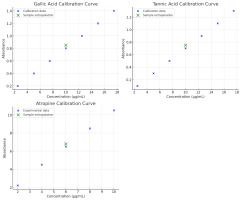
The contents of alkaloids, total phenolic compounds (TPC), and total tannins in the Gladiolus dalenii corms are summarized in Table 2. The data are expressed as mean ± standard deviation, with specific units for each component. Alkaloids were quantified as atropine equivalents (µg E AT/g) in dry weight, while total phenols and tannins were expressed as gallic acid equivalents (mg E GA/g) and tannic acid equivalents (mg E TA/g), respectively. The results showed that the total phenolic content (TPC) was 24.99 ± 0.85 mg E GA/g, while the total tannin content (TTC) reached 53.63 ± 0.87 mg E TA/g. The alkaloid content was notably high, at 116.7 ± 0.931 µg E AT/g, indicating a significant presence of these bioactive compounds.
Table 2
Total content of phytoconstituents in Gladiolus dalenii corms, including alkaloids, total phenols, and total tannins, expressed as their respective equivalents per gram of dry weight. Data are presented as mean ± standard deviation.
| Phytoconstituents | Total Content |
|---|---|
| Alkaloids (µg E AT/g) | 116.7 ± 0.931 |
| Total Phenols (mg E GA/g) | 24.99 ± 0.85 |
| Total Tannins (mg E TA/g) | 53.63 ± 0.87 |
Phenolic compounds are natural pigments with well-established biological activity, playing critical roles in protecting against external stimuli and eliminating reactive oxygen species (ROS), which are linked to the development of various diseases (Rana, Samtiya, Dhewa, Mishra, & Aluko, 2022). Alkaloids, on the other hand, are widely known for their psychoactive, analgesic, and antibiotic properties (Uzor, 2020; Wei Jiang 1, et al., 2022). These bioactive attributes provide support for the widely reported biological effects of G. dalenii, including antidiabetic, antimicrobial, anticonvulsant, and sedative activities (Adediwura & Kio, 2008; Odhiambo, Siboe, Lukhoba, & Dossaji, 2010; Ngoupaye, et al., 2013).
Minerals and Trace Elements in Gladiolus Corm Powder
The mineral analysis of Gladiolus corm powder revealed the presence of 12 essential and trace elements in varying concentrations, with chlorine (1390 µg/g) standing out. Its high concentration makes it relevant for maintaining electrolyte and acid-base balance in the body, with potential applications in therapeutic formulations or mineral supplements. Among the trace metals, nickel (4 µg/g) and strontium (4.4 µg/g) are noteworthy. Nickel plays a role in enzyme activation and urea metabolism (Siegbahn, Chen, & Liao, 2019), while strontium supports bone health and is used in osteoporosis treatments (Marie, 2005).
Iodine (4.2 µg/g), essential for thyroid hormone synthesis, suggests potential for supplementation in iodine deficiency cases (Lisco, et al., 2023), while zinc (2.3 µg/g) enhances the nutritional value of the powder, being vital for immune function, wound healing, and enzymatic activity (Rink & Gabriel, 2000). Chromium (2.4 µg/g) is significant for glycemic control and lipid metabolism (Zhao, et al., 2022), and copper (0.9 µg/g) is essential for hemoglobin formation and nervous system function (Lars-Oliver, Klaus-Dietrich, Darius, & Helmut, 2003). Despite its low concentration, selenium (0.1 µg/g) contributes to antioxidant functions, particularly as a component of glutathione peroxidase, helping to combat oxidative stress.
The presence of minerals such as chlorine, zinc, iodine, and chromium highlights Gladiolus corm powder as a potential source of complementary nutrition and mineral supplementation in deficient diets. Minerals like chromium and zinc expand their applications in therapeutic contexts, particularly in supporting glucose metabolism and strengthening the immune system. Iodine and strontium suggest specific applications for supplementation in deficiencies like thyroid disorders and bone health. Future studies should focus on the bioavailability of the identified minerals and their impact on human health to validate their applications in supplementation and nutraceutical formulations, consolidating Gladiolus corm powder as a promising therapeutic and nutritional resource.
Preliminary and Confirmatory Studies on the Antioxidant Activity of G. dalenii Corms
Antioxidants play a crucial role in food preservation by inhibiting oxidative processes that compromise quality and extending shelf life. Additionally, they have a significant impact on health promotion, being widely used in dietary supplements, nutraceuticals, and functional ingredients. Antioxidant activity can be assessed through various assays that explore different mechanisms of action, such as hydrogen atom transfer (HAT), single electron transfer (ET), reducing power, and metal chelation capacity, among others (Shahidi & Zhong, 2015).
In the present study, seven methods were applied to quantify the antioxidant activity of the hydroethanolic extract of Gladiolus dalenii corms, including FRP, FRAP, TAC, DPPH, ABTS, Folin-Ciocalteu’s, and Ferrozine, providing a comprehensive analysis of the antioxidant potential of the compounds studied.
Preliminary studies on the antioxidant activity of Gladiolus dalenii corms, conducted using the DPPH method, revealed that crude methanolic extracts (MCE) and the ethyl acetate fraction (EAF) exhibit high antioxidant capacity, with EC50 values of 6.55 μg/mL and 5.96 μg/mL, respectively (Cumbane, Magaia, & Estivila, 2022). The present study, while confirming the antioxidant activity of G. dalenii, highlights the direct impact of the extraction process, which limits both the concentration of bioactive compounds and the observed antioxidant efficacy compared to the more pronounced results of the previous study that employed exhaustive extraction. This methodological difference underscores the importance of extraction techniques in interpreting IC50 values, as the method directly influences the antioxidant performance of the extracts.
When comparing the antioxidant efficiency of G. dalenii corms with other natural sources or synthetic standards, it is essential to consider the extraction conditions, which can amplify or constrain the bioactive potential of the plant. In the study by Cumbane et al. (2022), exhaustive extraction using specific solvents, such as methanol and ethyl acetate, yielded fractions highly concentrated in phenolic compounds and flavonoids, resulting in competitive EC50 values comparable to standard antioxidants like rutin and BHT. Notably, the ethyl acetate fraction (EAF), with a high total phenolic content of 427.29 mg GAE/g DE, stood out for its exceptional antioxidant capacity (EC50 = 5.96 μg/mL).
The Folin-Ciocalteu’s method proved particularly effective in quantifying total phenolic compounds, such as those found in the ethyl acetate fraction (EAF), which exhibited an elevated content of 427.29 mg GAE/g DE in the previous study. These compounds are often responsible for the high antioxidant capacity observed in redox systems.
In contrast, the present study employed a non-exhaustive extraction approach, as the primary objective was to confirm the antioxidant activity identified in the preliminary study rather than optimize extraction methods or directly compare results with other studies. This methodological approach yielded relatively higher IC50 values, as observed in the DPPH method (165.17 ± 0.07 µg/mL), indicating that not all soluble bioactive compounds, such as phenolics and flavonoids, were fully extracted. Consequently, the concentration of these compounds in the analyzed extract was limited, directly impacting the observed antioxidant performance.
Despite this limitation, the results demonstrated moderate antioxidant activity, sufficient to position the corms of Gladiolus dalenii as promising natural sources of antioxidants. When compared to other species within the genus, such as Gladiolus illyricus, whose ethanolic extracts from corms and leaves exhibit IC50 values of 48.1 ± 1.08 mg/mL and 57.1 ± 1.27 mg/mL, respectively (Basgedik, Ugur, & Sarac, 2014), G. dalenii maintains competitive performance even with less efficient extraction methods. Additionally, when compared to Gladiolus segetum, whose ethyl acetate fraction presented an IC50 value of 441.16 ± 4.79 μg/mL (Marref, Benkiki, & Melakhessou, 2018), the corms of G. dalenii stand out as more effective in antioxidant activity.
The dose-response curves for the antioxidant activity of Gladiolus dalenii corms are presented in Figure 2. These curves provide significant insights into the behavior of bioactive compounds in the samples, assessed using various antioxidant methods. These findings are crucial for understanding antioxidant efficiency, the concentration required to achieve significant effects, and the practical implications for industrial applications.
Figure 2
Dose-response curves for the antioxidant activity of Gladiolus dalenii corms using various methods (DPPH, ABTS, FRAP, FRP, Folin-Ciocalteu’s, Phosphomolybdate, and Ferrozine). The curves show a common pattern of progressively increasing antioxidant activity with higher extract concentrations, reflecting the direct relationship between bioactive compound concentration and antioxidant capacity.
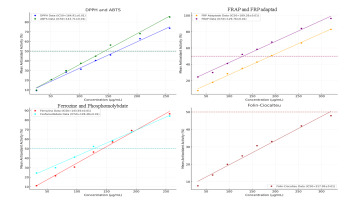
The dose-response curves, regardless of the method employed (DPPH, ABTS, FRAP, Phosphomolybdate, or Ferrozine), exhibit a common pattern—a progressive increase in antioxidant activity with higher extract concentrations. This behavior reflects the direct dependence between the concentration of antioxidant compounds and their capacity to neutralize free radicals or facilitate electron transfer. At lower concentrations, the observed antioxidant activity is moderate or low, indicating that only a limited fraction of free radicals are neutralized within this concentration range. As the concentration increases, the curves rise linearly, suggesting greater neutralization of the available free radicals.
DPPH and ABTS Methods
The DPPH assay is a popular, precise, and cost-effective colorimetric method for evaluating the antioxidant capacity of plant extracts and pure compounds. It is based on the reduction of the stable DPPH radical, which changes color from violet to yellow, with absorbance measured at 517 nm (Kedare & Singh, 2011). The dose-response curve in the DPPH method shows a linear pattern at initial concentrations, followed by a less pronounced slope at higher concentrations. This reflects the moderate efficiency of phenolic compounds and flavonoids present in the corms to donate protons and neutralize the DPPH• radical. The calculated IC50 value (164.17 ± 0.01 μg/mL) indicates that a significant amount of extract is required to achieve 50% inhibition, suggesting that the antioxidants exhibit moderate potency.
The principle of the ABTS antioxidant assay is based on the ability of antioxidants to quench a pre-generated ABTS radical cation (2,2'-azino-bis(3-ethylbenzothiazoline-6-sulfonic acid)), resulting in a decrease in absorbance at a specific wavelength, typically around 734 nm, proportional to the sample's antioxidant activity (Miller, Rice-Evans, Davies, Gopinathan, & Milner, 1993). The dose-response curve for the ABTS method is slightly steeper than that of DPPH, with an IC50 value of 143.71 ± 0.01 μg/mL. This highlights the greater sensitivity of the ABTS method, which evaluates antioxidant compounds in hydrophilic systems. The curve's behavior suggests that water-soluble compounds, such as tannins and glycosylated flavonoids, play a critical role in this system. Although both curves exhibit similar patterns, the ABTS curve demonstrates a more efficient response at lower concentrations, which may be attributed to the broader chemical scope of the method.
FRAP, Modified FRP, and Ferrozine Methods
The FRAP, Modified FRP, and Ferrozine methods evaluate the antioxidant capacity of bioactive compounds through electron transfer-based mechanisms. The FRAP method measures the reduction of ferric ions (Fe3+) to ferrous ions (Fe2+) in the Fe3+-TPTZ complex, forming an intense blue compound detected at 593 nm (Benzie & Strain, 1996). The Modified FRP method, optimized to minimize interference, also reduces Fe3+ to Fe2+ in the presence of ferricyanide, resulting in a blue complex measured at 700 nm (Berker, Güçlü, Tor, Demirata, & Apak, 2010). The Ferrozine method evaluates the formation of the Fe2+-Ferrozine complex, a magenta-colored compound detected at 562 nm, reflecting both the reducing capacity and metal chelation efficiency of the extract (Berker, Güçlü, Demirata, & Apak, 2010).
All three methods demonstrated a linear dose-dependent relationship (Figure 2), with a proportional increase in antioxidant activity as the extract concentration increased. IC50 values supported this trend: 129.76 ± 0.13 μg/mL (FRAP), 189.28 ± 0.01 μg/mL (Modified FRP), and 143.93 ± 0.01 μg/mL (Ferrozine). These results highlight the efficiency of bioactive compounds, such as flavonoids and tannins, in neutralizing free radicals and interacting with metal ions (Miller, Rice-Evans, Davies, Gopinathan, & Milner, 1993). None of the methods exhibited saturation within the tested concentration range, indicating potential for higher concentrations and suggesting that the antioxidant compounds have not yet reached their reactivity limit. This consistent pattern across methods reinforces the synergy among the antioxidant compounds and positions the corms of Gladiolus dalenii as a promising natural source of antioxidants for biological or industrial applications.
Phosphomolybdate (TAC) and Folin-Ciocalteu’s Methods
The Phosphomolybdate method evaluates the total antioxidant capacity of compounds present in Gladiolus dalenii corms through electron transfer. It measures the reduction of molybdate (Mo6+) to Mo5+ in the presence of antioxidants, forming a green complex detectable by spectrophotometry (Prieto, Manuel, & Aguilar, 1999). The dose-response curve showed a linear pattern, with an IC50 of 128.48 ± 0.01 μg/mL, indicating moderate antioxidant capacity and consistent efficiency of bioactive compounds within the tested concentration range.
The linear behavior of the curve, with no evidence of saturation at higher concentrations (up to 256 μg/mL), reflects the continuous efficiency of phenolic compounds and flavonoids in donating electrons and interacting with molybdate. However, the moderate IC50 may be attributed to the non-exhaustive extraction, suggesting that optimized methods could significantly enhance the observed antioxidant efficiency.
Unlike methods such as DPPH or ABTS, the Phosphomolybdate method measures total antioxidant capacity, complementing other assays by providing a broader view of antioxidant functionality. The absence of a plateau highlights the potential to explore higher concentrations and optimize extraction conditions to maximize the total antioxidant activity of this plant.
The Folin-Ciocalteu’s method assesses antioxidant activity primarily based on the phenolic content of the sample. The dose-response curve exhibited a positive linear relationship within the tested concentration range, with an IC50 of 317.99 ± 0.01 µg/mL, higher than other methods such as DPPH and ABTS, indicating lower sensitivity to the antioxidants in Gladiolus dalenii extracts.
The potential saturation observed above 256 µg/mL may reflect the limitation of the Folin-Ciocalteu’s reagent concerning the concentration of reducing compounds. While useful for estimating total polyphenol content, the method indirectly measures antioxidant capacity and can react with other reducing compounds, such as sugars and vitamin C, potentially interfering with the results (Pérez, Dominguez-López, & Lamuela-Raventós, 2023).
Despite its simplicity and sensitivity, the Folin-Ciocalteu’s method does not directly assess the neutralization of free radicals. Therefore, it should be used alongside assays such as DPPH, ABTS, or FRAP to provide a more comprehensive analysis of antioxidant potential. In summary, Folin-Ciocalteu’s is a reliable tool for estimating the antioxidant activity of phenolic-rich samples but requires complementary methods for a complete evaluation.
Antioxidant Capacity of Gladiolus dalenii vs Butylated Hydroxytoluene (BHT)
The graphs and IC50 values provide crucial insights into the antioxidant capacity of BHT across various chemical assays, reflecting its effectiveness in both lipophilic and hydrophilic systems. BHT is a synthetic antioxidant widely used as a food preservative due to its ability to inhibit oxidative reactions and extend product shelf life. Its efficiency is attributed to its electron-donating ability, capacity to neutralize free radicals, and interruption of oxidative chain propagation, particularly in fat-rich environments.
The results presented in Figure 3 illustrate the performance of BHT in methods such as Phosphomolybdate, FRAP, ABTS, Folin-Ciocalteu’s, and Ferrozine, each evaluating different aspects of its antioxidant activity. These assays provide a detailed analysis of its interaction with oxidizing agents, revealing both the effectiveness of BHT in neutralizing reactive species and its limitations in processes such as metal chelation.
Figure 3
Antioxidant activity of BHT evaluated using various chemical assays. The left panel shows the dose-response curves for the ABTS, Folin-Ciocalteu’s, and Ferrozine methods, with corresponding IC50 values. The IC50 values for each method, demonstrating BHT's efficiency across different mechanisms of antioxidant activity.
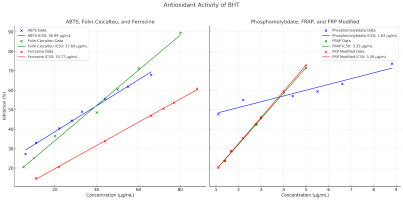
An integrated analysis of the results provides a comprehensive overview of the advantages and disadvantages of BHT, considering not only its high antioxidant efficiency but also the growing challenges related to its safety and consumer acceptance. These factors are crucial for contextualizing BHT within the current landscape, marked by a shift toward natural and sustainable preservatives.
The comparison between BHT and Gladiolus dalenii (G. dalenii) as antioxidants reveals significant differences in efficiency and applicability. BHT consistently demonstrated superior antioxidant capacity, reflected by significantly lower IC50 values across all evaluated methods. Methods such as Phosphomolybdate (IC50 = 1.63 µg/mL), FRAP (IC50 = 3.35 µg/mL), and Modified FRP (3.30 µg/mL) highlighted its superior electron-donating and metal-reducing abilities, while assays like ABTS (IC50 =36.99 µg/mL) and Folin-Ciocalteu’s (IC50 = 37.60 µg/mL) also showed good efficiency in neutralizing free radicals. These results reflect its lipophilic nature and chemical stability, characteristics that make it ideal for fat-rich systems and industrial applications (Petrescu, Vermeir, & Petrescu-Mag, 2020).
On the other hand, Gladiolus dalenii, despite showing higher IC50 values, demonstrated relevant antioxidant activity, particularly within the context of the non-exhaustive extraction method used in this study. Methods such as ABTS (143.71 µg/mL), Modified FRP (189.28 µg/mL), and FRAP (129.76 µg/mL) highlight that G. dalenii contains bioactive compounds with antioxidant potential, although its efficiency was limited by incomplete extraction. Preliminary studies using exhaustive extraction methods revealed that the crude MCE extract (IC50 = 6.55 µg/mL) and the enriched EAF fraction (IC50 = 5.96 µg/mL) outperformed both BHT (IC50 = 11.18 µg/mL) and rutin (IC50 = 9.11 µg/mL) in the DPPH assay. These findings suggest that, when properly extracted, G. dalenii can exhibit antioxidant capacity comparable to or even exceeding that of synthetic antioxidants.
The practical application of these results highlights the strengths and limitations of each antioxidant. BHT remains a highly efficient choice, particularly in lipophilic systems requiring low concentrations to inhibit oxidation. However, its associated toxicological concerns, such as nephrotoxicity, liver damage, genotoxicity, and carcinogenic risk, limit its use in food and cosmetic products, especially among consumers seeking safety and sustainability (Petrescu, Vermeir, & Petrescu-Mag, 2020). Conversely, G. dalenii, as a natural source of antioxidants, meets these demands by offering a safer and more sustainable alternative.
To maximize G. dalenii's potential as a natural preservative, it is essential to adopt optimized extraction methods that concentrate bioactive compounds, such as phenolics and flavonoids, which are responsible for their antioxidant activity. Additionally, combining G. dalenii with other natural antioxidants, such as vitamins C and E, could be considered to enhance its efficacy and stability in complex food systems. In summary, while BHT remains the most efficient antioxidant in terms of potency and cost, G. dalenii emerges as a promising alternative for applications prioritizing safety, naturality, and sustainability, paving the way for the development of healthier and more environmentally friendly preservatives.
Antimicrobial Activity of Gladiolus dalenii
This study evaluated the antimicrobial efficacy of Gladiolus dalenii, demonstrating broad-spectrum activity against various microorganisms, including bacteria (S. aureus, E. coli, P. aeruginosa) and fungi (C. albicans). The observed activity is attributed to the presence of bioactive compounds in the corms, such as flavonoids, alkaloids, tannins, and phenolic acids, aligning with previous studies on related species within the Gladiolus genus (Lim, 2014).
The Log Dose vs. Inhibition Zone (mm) graph shown in Figure 4 demonstrates the relationship between the logarithmic concentration of the G. dalenii extract tested and the diameter of the inhibition zone, revealing dose-dependent responses. Most microorganisms exhibited a proportional response to increasing doses. Lower initial doses resulted in more pronounced increases, while higher doses tended to plateau. For S. aureus and K. pneumoniae, a plateau was observed at doses ≥32 µg/disc, suggesting that the compound reaches its maximum efficacy. C. albicans exhibited the largest inhibition zone among all microorganisms, with a consistently ascending curve, indicating strong antifungal efficacy.
Figure 4
Log Dose vs. Inhibition Zone (mm) graph illustrating the relationship between the logarithmic concentration of G. dalenii extract and the diameter of the inhibition zone, showing dose-dependent responses.
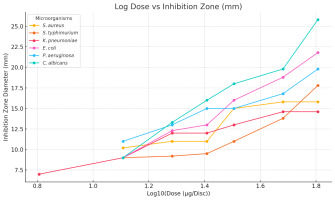
For S. aureus, minimal inhibition was observed at lower doses, with significant increases at 32 µg/disc, reaching a plateau of around 15.8 mm. This suggests a dose-dependent response but with limited efficacy at higher doses. For S. typhimurium, inhibition began at 12.8 µg/disc with a small zone (~9 mm). Gradual increases were observed with higher doses, reaching 17.8 mm at 64 µg/disc. The continued increase without a plateau indicates the potential for greater inhibition at higher doses. For K. pneumoniae, inhibition started at 6.4 µg/disc with a zone of 7 mm, making this microorganism more sensitive to lower doses. Inhibition increased continuously up to 14.6 mm at 48 µg/disc but stabilized thereafter, suggesting limited maximum efficacy against this microorganism.
For E. coli, inhibition started at 12.8 µg/disc (~9 mm) and significantly increased to 21.8 mm at 64 µg/disc. A clear dose-dependent response was observed without a plateau, indicating potential for greater efficacy at higher doses. For P. aeruginosa, inhibition began at 12.8 µg/disc (11 mm) and gradually increased. A plateau was observed around 15 mm for doses between 25.6 and 32 µg/disc, but further increases were seen at higher doses (19.8 mm at 64 µg/disc), suggesting moderate sensitivity with potential improvement at higher doses. For the fungus C. albicans, inhibition began at 12.8 µg/disc (~9 mm) and continuously increased, reaching 25.8 mm at 64 µg/disc. The consistent increase without a plateau indicates high efficacy against this fungal strain.
This study confirms the previously reported antimicrobial potential of G. dalenii, which demonstrated significant activity against P. aeruginosa and fungi such as A. niger (Ameh, Obodozie, Olorunfemi, Okoliko, & Ochekpe, 2018; Lim, 2014). Flavonoids, tannins, and alkaloids, bioactive compounds commonly reported in the Gladiolus genus, are likely responsible for the observed potency (Ameh, Obodozie, Olorunfemi, Okoliko, & Ochekpe, 2018; Lim, 2014). The presence of these metabolites in G. dalenii explains its efficacy, as studies show that such compounds possess antimicrobial properties (Cushnie, 2005; Yan, et al., 2021; Huang, et al., 2024). G. dalenii surpasses G. illyricus in antifungal activity, particularly against C. albicans, and its activity against E. coli and S. typhimurium highlights its potential for treating Gram-negative bacterial infections. At doses as low as 64 µg/disc, it achieved an inhibition zone of 25.8 mm, showing competitive efficacy compared to nystatin, which requires a dose eight times higher (500 µg/disc) to achieve a slightly larger inhibition zone (28.48 mm) (Mansourian, Boojarpour, Ashnagar, Beitollahi, & Shamshiri, 2014). This performance positions G. dalenii as a strong candidate for development as a natural antifungal agent with therapeutic and preservative applications.
These findings emphasize the need for further studies on the toxicity of G. dalenii. While its antimicrobial efficacy is promising, especially against fungi such as C. albicans, future investigations should focus on determining its impacts on organic tissues, such as the liver, and ensuring its safety for long-term applications.
Safety Considerations for the Use of Gladiolus dalenii
The application of Gladiolus dalenii in therapeutics and the food industry should be approached with caution, particularly due to the presence of bioactive compounds, such as cardiotonic glycosides, which may pose health risks (Botelho, Pierezan, Soto-Blanco, & Melo, 2019). Studies on G. dalenii indicate potential risks of oral toxicity. Acute toxicity tests determined a median lethal dose (LD50) of 2116.60 mg/kg for the aqueous extract (Ishaq, et al., 2017), suggesting that while promising, its use should be controlled to avoid adverse effects.
Additionally, histological analyses of the livers of rats administered oral doses between 1600 and 5000 mg/kg revealed hepatic cellular damage, reinforcing the potential toxicity of high doses (Ishaq, et al., 2017). These findings highlight the need for caution in the internal use of G. dalenii extracts, as well as the importance of further studies to evaluate its safety in long-term applications.
Although G. dalenii has demonstrated significant antioxidant and antimicrobial potential, its responsible use requires a detailed assessment of its impacts on organic tissues and the establishment of safe limits for applications in humans and animals.
Conclusions
The findings of this study highlight the significant potential of Gladiolus dalenii corms in various scientific fields, including phytochemistry, antioxidant capacity, antimicrobial activity, and mineral analysis. The broad diversity and richness of the identified compounds provide a solid foundation for exploring their industrial and therapeutic applications, reinforcing the value of this species as a potential source of bioactive compounds.
The presence of flavonoids, tannins, and alkaloids in G. dalenii corms directly contributes to its remarkable antioxidant and antimicrobial activities. In particular, its notable efficacy against Candida albicans suggests its potential as a natural antifungal agent, opening avenues for its use in the development of plant-based antimicrobial products. Additionally, the mineral analysis revealed significant levels of chlorine, iodine, and chromium, emphasizing its nutritional value and possible therapeutic applications.
However, the toxicity associated with high-dose consumption, as reported in the literature, underscores the need for further studies to evaluate the safety of this species, particularly in food and pharmaceutical formulations. Future research should focus on elucidating the mechanisms of action of its bioactive compounds and determining safe consumption levels for human use.
Thus, G. dalenii emerges as a promising candidate for applications in the food and pharmaceutical industries, provided that complementary studies are conducted to ensure its practical viability, safety, and efficacy.
Acknowledgments
The authors would like to extend their gratitude to the Instituto Superior de Ciências e Tecnologia de Moçambique (ISCTEM) and the Laboratório de Engenharia de Moçambique, particularly Engineer Elautério Mondlane, for providing the essential facilities and support that made this work possible.


